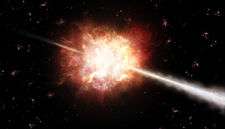GRB 050509B
 | |
| Other designations | GRB 050509B |
|---|---|
| Event type | gamma-ray burst |
| Detection | |
| Date | 9 May 2005 |
| Duration | 40±4 millisecond |
| Instrument | Swift Gamma-Ray Burst Mission |
| Location | |
| Constellation | Coma Berenices |
| Right ascension | 12h 36m 13.9s |
| Declination | +28° 59′ 01″ |
| Redshift | 0.225±0.001 |
| Energetics | |
| See also | |
GRB 050509B was a gamma ray burst (GRB) observed by the NASA Swift satellite on May 9, 2005. It was the first short duration GRB for which an accurate positional measurement was made, accurate enough to locate it near to an elliptical galaxy lying at a redshift of 0.225.
The significance of this finding is that it lends support to the theory that short bursts are formed during the catastrophic merger of two neutron stars, or a neutron star and a black hole. The orbital decay (via gravitational radiation) of stellar binaries consisting of these exotic compact objects is believed to take hundreds of millions of years, hence gamma ray bursts produced this way would be expected to be located in old (misleadingly called "early type") galaxies. In contrast, long-duration gamma ray bursts, which are believed to result from the collapse of a single massive star, are expected to be located preferentially in young galaxies.
References
- David Whitehouse (11 May 2005). "Blast hints at black hole birth". BBC News. Retrieved 12 July 2011.